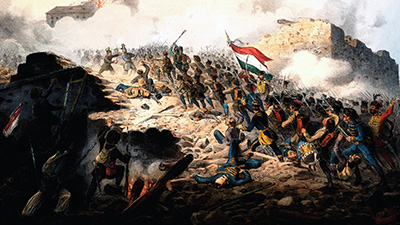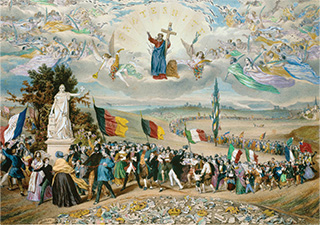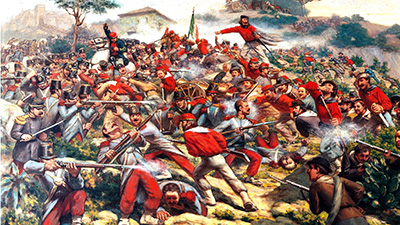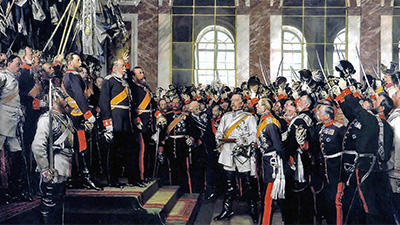Nationalism Spreads
Teacher Resources
Driving Question: What caused nationalism to spread around the world in the nineteenth century?
Discover how people around the world started to embrace nationalism for a variety of reasons, among them a growing sense of ethnic pride, a response to multiethnic regionality, or because they saw it as a pathway toward economic and political independence.
Learning Objectives:
- Analyze the causes and consequences of world revolutions such as those in Europe, Asia, and the Middle East to understand the growth and spread of nationalism.
- Evaluate the reasons behind the successes and failures of the revolutions of 1848.
- Use the historical thinking practice of change and continuity over time to evaluate how the world changed after 1750.
Vocab Terms:
- ethnic nationalism
- ideology
- independence
- liberal
- nation
- nationalism
- nation-state
Opener: Nationalism Spreads
To teach this lesson step, refer to page 2 of the Lesson 4.5 Teaching Guide.
We have a Three-Step Reading Tool just for graphic bios! It’ll guide your students to observe, understand, and connect.
Ethnicity and Nationality
To teach this lesson step, refer to page 3 of the Lesson 4.5 Teaching Guide.
The revolutionary ideas of this period got their start around the Atlantic Ocean, but they didn’t stay there. Soon, a new sort of identity—one based on ethnic identification—emerged in some of Europe’s old empires.
-
Guiding Questions
-
Before you read
Preview the questions below, and then skim the article. Be sure to look at the section headings and any images.
While you read
Look for answers to these questions:
- What is ethnicity?
- Why was ethnic nationalism such a threat to the Ottoman and Hapsburg Empires?
- How did nationalist ideas spread to Greek communities?
- What was the dark side of ethnic nationalism?
After you read
Respond to this question: Does nationalism liberate people or does it oppress them?
Springtime of Nations
To teach this lesson step, refer to page 4 of the Lesson 4.5 Teaching Guide.
Explore this blog post, What do historians know about writing that students (usually) don’t? to dive deeper into informal writing and other essential writing skills.
The revolutions of 1848 were a flame that spread across Europe—and beyond. In this article, you’ll read about the dozens of countries where revolts erupted, and in the activity that follows you’ll consider why they failed.
-
Guiding Questions
-
Before you read
Preview the questions below, and then skim the article. Be sure to look at the section headings and any images.
While you read
Look for answers to these questions:
- What caused the revolutions of 1848 in Europe?
- Why did the revolutions of 1848 fail?
- What effects did the Taiping Revolution and the Great Revolt of 1857 have on British power in Asia?
- Why did all these revolutions happened around the same time?
- From Europe to China, what was the common effect of the failed world revolutions from 1848 to 1865?
After you read
Respond to this question: What could the revolutionaries discussed in this article have done differently to ensure the success of their movements?
Connecting Revolutionary Movements
To teach this lesson step, refer to page 2 of the Lesson 4.5 Teaching Guide.
For a quick review of how OER Project addresses CCOT, take a look at the OER Project CCOT One-Pager.
The transoceanic connections forged before 1750 helped lay some of the groundwork for the revolutionary movements that emerged later. In this activity, you’ll trace what changed and what stayed the same.
Closer: Nationalism Spreads
To teach this lesson step, refer to page 8 of the Lesson 4.5 Teaching Guide.
Get an idea of how other teachers use Unit Notebooks by checking out DQ Notebook – Best Practices Share in the Community Forum.
Nationalism emerged from the ideas that were born of the Enlightenment and political revolutions. Together, these forces reshaped our world. How have they reshaped your thinking?
Forging Nations
To teach this lesson step, refer to page 8 of the Lesson 4.5 Teaching Guide.
Nationalist movements in Germany and Italy forged powerful nation-states from divided and decentralized regions. Compare the strategies they used to achieve their ends.
-
Guiding Questions
-
Before you read
Preview the questions below, and then skim the article. Be sure to look at the section headings and any images.
While you read
Look for answers to these questions:
- Describe the Italian peninsula before 1800. How were political communities organized?
- How did Napoleon help start Italian nationalism?
- Why did the revolutions of 1848 fail to create a unified Italy?
- What helped Count Cavour succeed in defeating the Austrians and establishing the Kingdom of Italy in 1861?
After you read
Respond to this question: Most nationalist histories are told from the perspective of male leaders. How do you think the story is different when told from the perspective of a woman who was a commoner?
-
Guiding Questions
-
Before you read
Preview the questions below, and then skim the article. Be sure to look at the section headings and any images.
While you read
Look for answers to these questions:
- Describe Germany before 1800. How were political communities organized?
- What does Snow White have to do with German nationalism?
- What role does the author say violence played in creating the German state?
- Why did Bismarck succeed against internal and external opposition?
After you read
Respond to this question: Do you think nationalism was more a result of the actions of a few great leaders, or more the result of wider historical forces?








